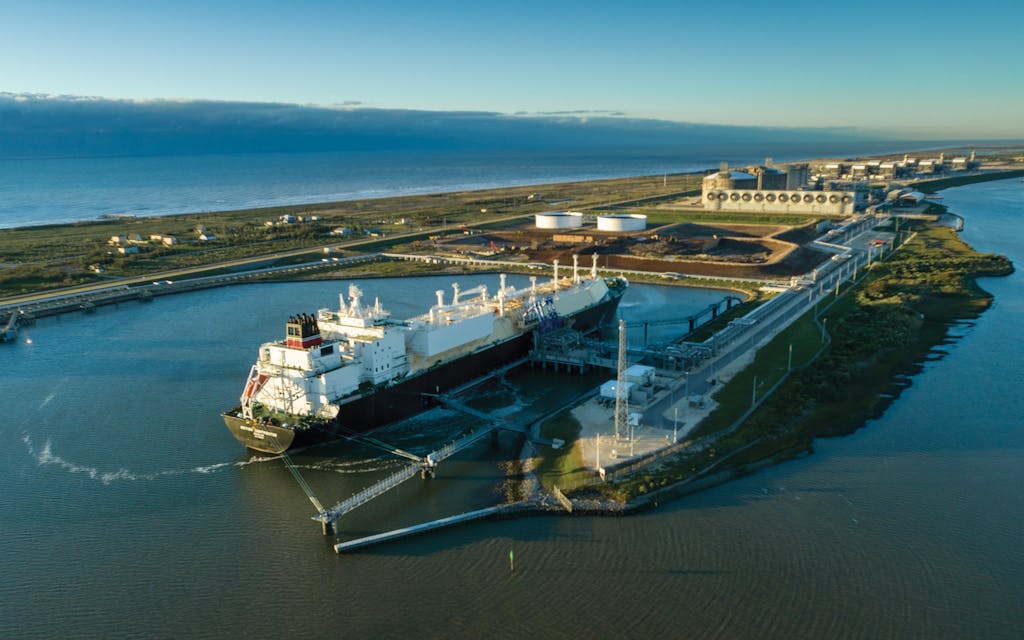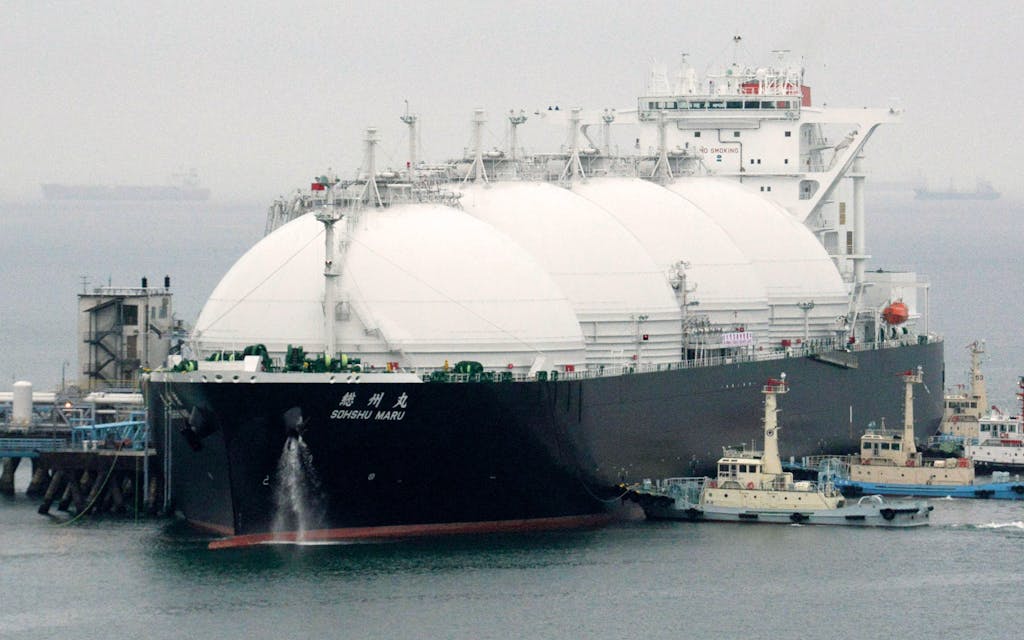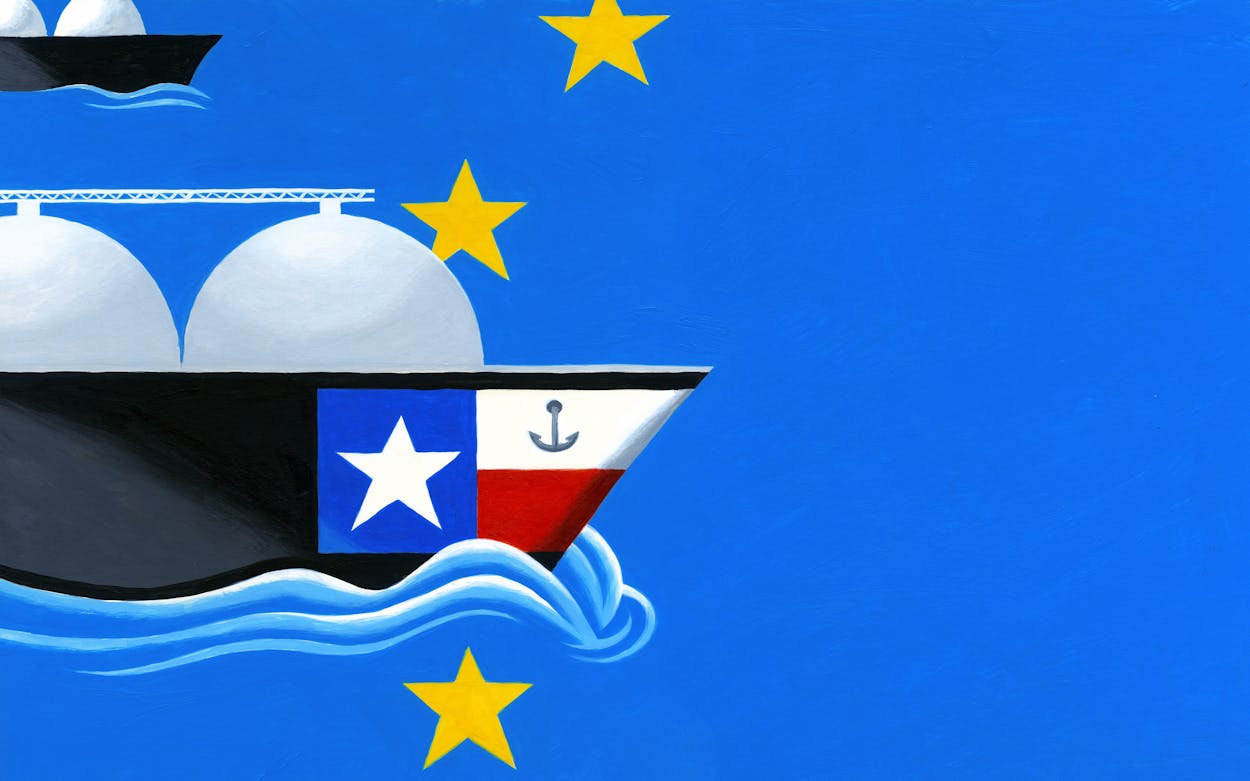The tanker LNG Rosenrot was moored in a harbor off Quintana Island, sixty miles south of Houston and across a causeway from the coastal town of Freeport. The ship filled its tanks with enough liquefied natural gas to power the entirety of France for a day or every home in Texas for a week. It was originally slated for a routine journey through the Panama Canal and onward to a port in China. But natural gas prices were spiking across the Atlantic, and on that day in December, the captain’s orders changed.
The Rosenrot—a vessel so large that if you stood it on its stern, it would rank as the third-tallest building in Texas—slowly pulled away from its berth, slid into the Gulf of Mexico, and turned eastward toward stops in the Netherlands and the United Kingdom. Europe was plunging into its worst energy crisis in a generation, and Texas gas was sailing to the rescue.
European nations had tapped heavily into their energy reserves in early 2021, and those supplies hadn’t been replenished. As global economies emerged from pandemic lockdowns last summer, natural gas production lagged behind, resulting in stiff global competition for what was available. Europe ultimately entered 2022 with nearly 30 percent less gas on hand than usual. At the same time, Russia, the continent’s biggest gas exporter, reduced the amount it sent west by nearly 25 percent.
As prices soared, mothballed coal power plants in Europe restarted, and factories that consumed natural gas were idled. More and more tankers carrying LNG headed for the Continent—roughly twice as many this January as in January 2021. One result was a maritime traffic jam off the coast of Barcelona, among Europe’s largest import terminals. Many of those ships were coming from the Gulf Coast, mostly Texas and Louisiana. European governments and utilities that had initially turned up their noses at gas from Texas—because it requires fracking and because lax state regulations allow its production to leak large volumes of the potent greenhouse gas methane—were suddenly desperate for it.

Then, prices spiked in the immediate aftermath of the late February invasion of Ukraine by Russian armed forces. Traders and governments worried that gas flows could be further reduced in response to the imposition of sanctions on Russia, a punitive measure against Vladimir Putin’s unprovoked aggression. Texas gas looked more attractive than ever as European leaders felt newly motivated to seek out supplies of energy that couldn’t simply be cut off at an autocrat’s whim.
Such concerns about energy security were likely in the minds of the executive body of the European Union earlier this year, when it unexpectedly (and pragmatically) proposed that natural gas should count as transitional “green” energy. The decision would mean that the EU’s 27 countries could subsidize new natural gas plants so long as any new facilities met certain emissions standards and replaced plants that were even more polluting, such as those fueled by coal.
The EU’s proposed policy represented quite a U-turn. In 2019 then–secretary of energy (and former Texas governor) Rick Perry embarked upon a sales trip to get Europe to import more LNG from the United States. The energy department began calling it “freedom gas” and said “molecules of U.S. freedom” were available for export. Outside of Poland, Europe’s reception was lukewarm at best.
“To put it mildly, gas is over,” pronounced Werner Hoyer, a German economist and president of the European Investment Bank, in early 2021, citing the need to end fossil fuel investments to reach climate goals. This wasn’t just rhetoric. In October 2020 the French government indefinitely postponed a $7 billion deal to import LNG from the Port of Brownsville because Texas regulators allow the gas to be produced and piped in a way that generates unnecessary emissions that contribute to global warming. Sweden had blocked a proposed natural gas import terminal in 2019 for similar reasons.
That was then. Now European companies and ports are “taking the cargoes, and they don’t care where it is coming from,” says Michael S. Smith, founder, majority owner, CEO, and chairman of Freeport LNG, the company that operates the Quintana Island facility through which gas is flowing across the Atlantic.
If European demand remains high, the Gulf Coast has plentiful gas in the ground to export, but it would take years to build additional facilities for sending much more overseas. Two of the five terminals that account for more than 90 percent of American LNG exports are in Texas: Freeport LNG and Cheniere Energy’s facility in Corpus Christi. Another terminal is under construction on the Texas side of Sabine Pass. The United States is expected this year to become the world’s largest LNG exporter, surpassing Australia and Qatar, with Texas accounting for almost 40 percent of U.S. trade. (Louisiana ranks first among the states, with 52 percent.)
Smith, a little-known, self-made billionaire, has watched the growing popularity of his terminal from his home in Miami, with mixed emotions. He believes it’s harmful for the industry when natural gas prices reach the record levels the Europeans have faced, topping $44 per thousand cubic feet, because that could drive consumers to alternatives. (In the U.S., natural gas hasn’t topped $7 in more than a decade and at press time was about $4.50. Because gas must be moved by pipeline or specialized tanker, prices can vary widely from continent to continent. Gas is far less expensive in North America than elsewhere.) “But I’m elated that the world is getting to see how important the U.S. LNG industry is to worldwide demand,” Smith says, and “for those who are not anti–anything fossil fuel or have their head in the sand, to see we’re a vital part of the ability to convert to a green future.”
This may sound like a standard pro–fossil fuel spiel from the chairman of a large Houston-based energy company—and it is. But it also sounds a lot like what’s being said these days in Berlin, Brussels, and Paris. This year could prove a turning point in Europe’s fractured relationship with Texas natural gas. If it does, might a growing European market force the state’s operators and regulators to rein in climate-damaging emissions? Or will Europe’s newfound willingness to buy gas from wherever it’s available undermine any push to get the state’s industry to clean up its act?


Texas wouldn’t be nearly as well positioned to supply Europe without the determination of Smith, a white-haired 66-year-old New Yorker who came to Houston after selling his Denver-based oil exploration company in 2001.
(Despite decades away from his childhood home, he retains a distinctive “New Yawk” accent. “Source” sounds like “sauce” and “dollar” becomes “dallah.”) It’s a minor miracle his Freeport LNG export terminal exists. Built on a marshy island, the $15 billion project was conceived in 2001 and weathered so many setbacks that even Job might have thrown in the towel. The facility didn’t fill up its first LNG vessel until the final days of 2019.
The gas traveling through Freeport to Europe begins its journey deep underground, most often in the Permian Basin or Louisiana’s Haynesville Shale, locked away in the spaces between rocks, where temperatures can exceed 250 degrees Fahrenheit. Fracking frees the gas from its subterranean sauna. Up from the earth, the gas is compressed and shunted into one of several pipelines. (Texas Monthly’s chairman owns interests in the midstream oil and gas industry, among other investments. Texas Monthly maintains editorial independence from those interests.)
Freeport LNG takes control of the natural gas just short of the coast, at a metering station off a two-lane country road, one of innumerable hydrocarbon way stations in the area. By then, the gas has likely cooled to about 80 degrees or, in the summer, a bit warmer. It’s pumped into a buried steel pipeline that’s large enough for a person to comfortably crawl through. Next comes a ten-mile trip south below one of the most industrialized waterfronts in the world. The gas travels under bottomlands and the Intracoastal Waterway, past several large petrochemical plants (BASF, Dow, Huntsman) and Surfside City Hall, then beneath a channel and onto Quintana Island. There, it enters Smith’s giant plant, which converts the gas to a liquid by lowering its temperature to –260 degrees Fahrenheit. Liquefaction significantly reduces the gas’s volume, making it easier to ship. It’s bottled up in a thermoslike tanker leased by one of Freeport’s customers, such as BP or Japan’s JERA, and shipped around the world.
None of this is what Smith set out to do. He hadn’t planned to export gas at all. He started working on the facility at a time when most experts believed that the U.S. would soon use up its natural gas deposits. Smith intended to build an import terminal that would take superchilled LNG from tankers and raise its temperature until it could be injected into pipelines. On the first day of the facility’s construction, in about 2005, the ground was so muddy that an excavator sank halfway into the muck. The driver escaped through a window in the cab of the machine. Workers spent thirteen months stabilizing the soil before heavy equipment could safely maneuver on it.
By the time the import terminal was ready for business, in 2008, global energy markets had transformed. Modern fracking had opened vast new gas reserves and turned the U.S. from gas-poor to gas-rich. In 2010 Smith reversed course and built a whole new facility, adjacent to the one he had just erected, to export gas. This required new financing and federal permits. Along the way, two of his construction contractors went bankrupt, as did a company that had signed a long-term agreement to use the terminal. As if those weren’t trials enough, in 2017 Hurricane Harvey struck and forced further delays just as construction got into high gear.
In December 2019, the tanker Golar Arctic pulled out of its berth at Quintana Island, bound for South Korea and bearing the terminal’s first commercial cargo. Smith drove from Houston to watch it depart. He had secured long-term contracts for the facility and stood to make money whether its two berths were occupied or sitting empty. (Smith says he owns more than 60 percent of Freeport LNG, which is a privately held company.) His perseverance has made him a billionaire—possibly a few times over. “As Charles Darwin would probably agree, it’s not the strongest or the most intelligent who succeed, but those who can best manage the disruptive challenges of change,” he said at a luncheon in 2018 at Colorado State University, where he had studied in the seventies before dropping out to become a ski bum a few courses shy of a degree.
Almost as many tankers carrying natural gas sailed out of U.S. terminals in 2021 as in the previous two years combined—not only from Freeport LNG but also from Cheniere’s terminals in Corpus Christi and on the Louisiana side of Sabine Pass. Studies paid for by the industry, as well as those from the federal government, agree that the LNG boom is boosting the regional economy. They suggest that more exports generate additional natural gas drilling across the region, creating jobs and tax revenue while keeping domestic prices from rising significantly.
But there are legitimate concerns. By the end of the year, the country could be exporting 12 percent of the gas it produces. Ten U.S. senators—nine Democrats and an independent—wrote to the secretary of energy in February urging her to “take swift action to limit U.S. natural gas exports and examine their impact on domestic energy prices.”
There are also significant environmental consequences—not just for local communities but for the global climate—of even more gas drilling, pipelines, and export terminals sprouting up along the Gulf Coast. About 3 percent of the gas produced in the Permian Basin escapes into the atmosphere, where it contributes to climate change. (A 2018 study in the journal Science found that nationwide the emissions rate is 2.3 percent, with some areas below 2 percent.) “The impacts to our health, environment, and economy are greater than any benefit that fracked gas can provide,” says Elida Castillo, an environmental activist from Taft, a small town outside Corpus Christi, who campaigns against the expansion of Texas natural gas and LNG. “The costs outweigh any benefit.”

Once Europe’s energy crisis subsides, it might again close its ports to Texas natural gas. “On the brink of disaster, Europe is welcoming gas from Texas or anywhere else that can ride in to the rescue,” says Daniel Cohan, a professor of environmental engineering at Rice University. “Once this crisis fades and alternatives proliferate, Europe is likely to return to being choosier about the fuels it imports.” That could lead it to again move away from gas-fired power plants in favor of nuclear energy or renewables. Russian gas is the wild card. Will European nations get away from it as quickly as possible? Or will Russia, in a bid to preserve its market share, cut prices to below $10, levels at which American LNG can’t compete in the long term?
Indeed, there are signals, even amid the recent rush to embrace the state’s gas, that Texas players will need to change their ways if they wish to retain their new European customers. The French utility Engie, which had pulled out of the $7 billion LNG deal in Brownsville, quietly signed a comparable deal in June to import LNG from Cheniere’s Corpus Christi terminal—with conditions. Anatol Feygin, Cheniere’s chief commercial officer, told me that the Houston-based company helped clinch the deal by pledging transparency about its greenhouse gas emissions. “That body of commitments was absolutely critical for the French guys to get comfortable with a long-term commitment,” he says. Smith, at Freeport, plans to implement something similar. “We’re in the process of doing a system to track our molecules,” he says, which would enable the company to find and replace leaky valves.
Cheniere released a peer-reviewed paper—written with academics at the University of Texas at Austin and Duke University—that showed that its wellhead-to-import-terminal emissions make its gas a cleaner alternative to coal. Numerous studies have agreed that burning gas to make electricity—as long as leakage rates are controlled—is much better for the climate than burning coal. Others argue that LNG is far from green because of the huge electricity needs for chilling the gas and its production’s reliance on a leaky gas-gathering system. David Lyon, a senior scientist at the Environmental Defense Fund, says Cheniere’s estimate of how much methane it leaks into the atmosphere is too low. He points out that Cheniere’s study relied on a federal greenhouse gas reporting program that has been widely criticized. “There have been numerous studies which demonstrate that the reporting program underestimates emissions,” he says. Still, he applauds Cheniere’s efforts as “an important step.”
In late January, I drove to Freeport LNG, arriving in the early morning. The facility is nearly two miles long and takes up most of the width of the island. I parked across the channel, in Surfside, to get a view of the vessels being filled. One was the maroon-and-white Global Sea Spirit. Dolphins surfaced near the ship, avoiding a Coast Guard boat speeding out toward deeper water. By sunset, two tugboats—Thor and Exporter—had guided the tanker toward the Gulf of Mexico. Once in open waters, it turned east, passing between Florida and Cuba on its way to Poland. Later that evening, the Aristidis I arrived at Quintana Island to take on its cargo.
Such ships are maritime extensions of the fracking revolution, which gave the U.S. so much gas that it could send LNG tanker after LNG tanker abroad while domestic gas prices barely budged. Right now natural gas sellers have the upper hand, but one day soon that advantage might shift to the buyers. It’s not hard to imagine a time when European utilities assess a carbon tax on the emissions from Permian Basin gas production. Then what? Maybe Texas will get serious about stopping gas flaring and methane leaks. It’s not hard to imagine a world in which the decrees of the European Commission, in Brussels, are as impactful on Texas gas operations as those from the Railroad Commission, in Austin.
Correction: An earlier version of this article overstated the number of tankers that sailed from U.S. terminals in 2021 compared to the previous two years.
This article appeared in the April 2022 issue of Texas Monthly with the headline “Texas Rescues Europe.” It originally published online on February 14, 2022. Subscribe today.









